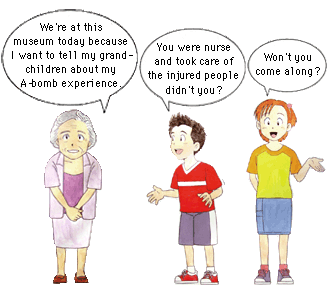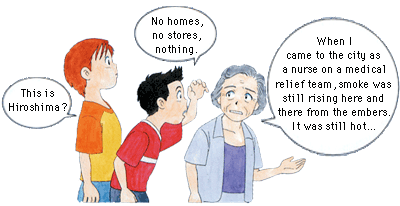 |
 |
| Preparing for Air Raids |
|
Japan took advantage of the Manchurian Incident in 1931 to start a war with China,
a war that would last over 15 years and involved every Japanese man, woman, and child in the war effort. Enactment of the Air Defense Law in 1937 required all citizens to prepare for air raids. Full-scale air-raid drills were held to practice fire-fighting, rapid evacuation, and rescue techniques. In addition to the massive air-raid drills held by the military, smaller drills were implemented by neighborhood associations and schools. The people of Japan were thoroughly trained to be aware of and prepared for air raids. As the Pacific War, started in 1941, turned against Japan and the US military began actually bombing Japanese cities, a more detailed air-raid system was established. In Hiroshima, children were evacuated and houses were demolished for fire lanes designed to stop the spread of fire after an air attack. Arrangements were made to have food and clothing sent in from surrounding towns and villages, and everyone was assigned to a place of refuge where victims would receive care. Doctors and nurses were not allowed to evacuate Hiroshima, and relief stations to treat air-raid victims were established around the city. |
 |
1 The start of the war April 28 and 29, 1938 / Jiangsu Province, China After the Manchurian Incident in 1931, the Japanese army repeatedly attacked the Chinese army in China. On July 7, 1937, a battle at the Marco Polo Bridge on the outskirts of Beijing led to a declaration of all-out war between Japan and China. From that point on, tens of thousands of soldiers were called up. |
| 2 Full-scale air-raid drills August 6, 1933 / Hiro-mura, Kamo-gun (now Hiro, Kure City) The rapid development of airplane technology completely transformed the nature of war. No longer was war confined to battlefields near the front. The fighting reached far across the front lines to involve non-combatant civilians far from any battlefield. This led to frequent air-raid drills designed to prepare the people for bombing raids. In the course of these air-raid drills, the people were under a war regime and thoroughly trained in air-raid preparations and measures. |
 |
 |
 |
| 3 The formation of civil defense teams To strengthen the air-raid defense system and help protect the general population from air raids and other disasters, civil defense teams were formed in 1939. These teams integrated fire-fighters with the air defense units that had previously focused on air-raid defense. Most members had other jobs, but in the event of an air raid, they were placed under police supervision to communicate warnings, fight fires, lead evacuations, or carry out rescue and relief activities. |
4 Civil defense team arm badge |
 |
 |
| 5 Neighborhood air-raid drills 1940 / Hijiyama-hon-machi Under the direction of civil defense teams, air-raid drills were held by neighborhood associations. During fire-fighting drills, people would form bucket brigades. Buckets and hoses were prepared by each family so that in the event of fire they could fight it collectively with their neighborhood. |
6 Air-raid hood |
 |
 |
| 7 Preparing homes Pamphlets and posters distributed by neighborhood teams taught how to prepare for air raids in great detail. They included lists of items to have on hand, instructions on making a bomb shelter, instructions on ensuring that no light escaped the house at night, and much more. |
8 Light bulb for blackouts |
 |

|
| 9 The formation of Hiroshima City Medical Association relief teams 1942 / Hiroshima Gokoku Shrine Moto-machi In preparation for relief activities in the event of an air raid, medical personnel were forbidden to evacuate. Relief teams were formed comprising doctors, dentists, pharmacists, nurses, and staff. Revolving around these teams were the neighborhood associations and civil defense teams, who would assist them with rescue and relief. Medical relief team members received emergency bags and metal helmets. They were expected to be ready to begin relief activities at any moment. |
10 Air defense order Treatment of the injured was an extremely important air defense task. According to the 1937 Air Defense Law, in the event of an air raid, doctors, nurses and other medical personnel were to be mobilized for emergency relief activities. This order was distributed to inform those in such positions. |
| 11 Emergency preparation of rice balls Preparing for air raids, taking victims into shelters, supplying food and clothing---everything was planned. In the event of air attack, schools and temples in surrounding towns and villages were to be available for refuge, and emergency rice balls and clothing were to be distributed. |
 |
 |
| 12 Hiroshima City's evacuation plan The Hiroshima City Mass Evacuation Summary was enacted in April 1945 in preparation for a major fire due to air raid. Evacuation was to be a last resort implemented only if fire was uncontrollable and spreading over a large area. Each neighborhood had its assigned place of refuge where food and medical supplies were stored, and people were to make their own decision about evacuating without waiting for orders from the mayor or police chief. Individual citizens were all instructed to learn in advance where their refuge was and how they would get there. |
 |
 |
| 13 Intensifying air raids July 2, 1945 / Kure City With the war situation worsening, the US stepped up its air raids. At first, the targets were military factories and military facilities, but gradually, attacks began indiscriminately targeting civilian populations. With hundreds of bombs raining on cities, their carefully planned air-defense plans became virtually useless. |
14 The atomic bombing August 6, 1945 The atomic bomb dropped on Hiroshima on August 6, 1945, produced powerful heat rays and blast. It also emitted massive amounts of radiation that inflicted serious damage to human bodies. A single bomb turned most of Hiroshima City into a burned plain. Countless people died. The city instantly burst into utter turmoil. |
 |
| 15 The city turned into a burnt plain August 7, 1945 / Looking southeast from Fukuya Department Store Ebisu-cho (800m from the hypocenter) |

| Helping
Victims in the Burnt Plain -- Relief Activities with neither Medicine nor Food to Offer -- Preparing for Air Raids Relief Activities amid the Turmoil Full-scale Relief Activities Conditions in Relief Stations and the Suffering of the People(1) Conditions in Relief Stations and the Suffering of the People(2) Relief Activities by the Akatsuki Corps on August 6 Conclusion Individuals and Group Contributors to This Exhibition Return to TOP |